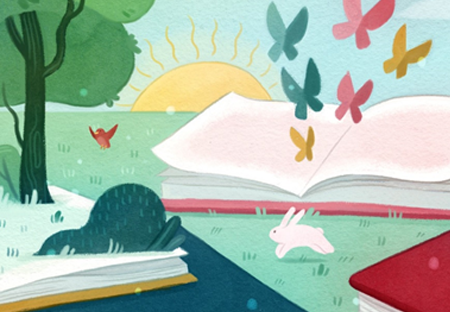
It's everything science in this issue of ChildrensLit Now! Fostering an interest in science and nature at a young age benefits society and the universe. This month we feature great new nature and science-themed books perfect for children eight and under. You'll also meet one of Children's Literature's longtime science reviewers, astronomer Francine Jackson. Francine is a perfect example of the importance of science books for young readers. And meet Sneed B. Collard III, author of 85 children's books, honored with the Washington Post-Children's Book Guild Award for Nonfiction for his body of work, and whose STEM and STEAM presentations get children motivated to learn more about nature and animals.
Shelley Oakley
Director, Children’s Literature review source
Subscribe to ChildrensLit Now Newsletter
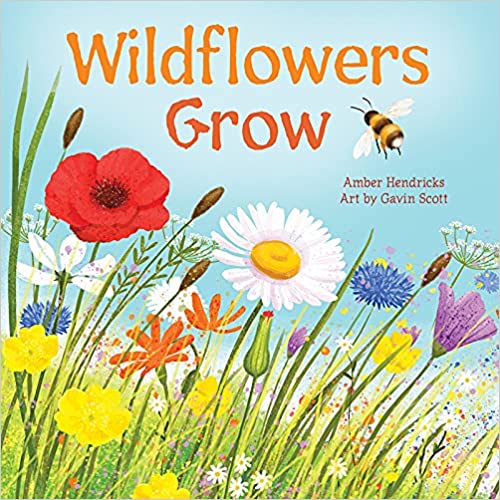
In this beautifully illustrated board book, young children will learn about the lifecycle of a seed. Beginning with its first moments under the soil and culminating with the emergence of a lovely wildflower, the journey of a seed from a seemingly inanimate object to a wonderful plant is a joy to behold. Along the way, readers and listeners will not only encounter the changing phases of a seed's lifecycle but also the other living things that surround it. In turn, creatures such as a hard-working ant, a burrowing mole, a scurrying mouse, and a busy bee all enter into at least the periphery of a seed's life. Slowly but steadily, the seed begins to germinate, sends out roots and what will become its stalk, pushes its way out of the earth, and stretches up towards the sun. By the book's end, this singular seed joins countless others to become part of a prairie bursting with life and color. All along the seed's evolution, it remains part of a much broader ecosystem that hinges on the interaction between a vast panoply of living things. Told with care and beautifully augmented by the striking artwork of the illustrator, this is a book that should spur young children to go into their backyard, a park, or a nearby garden and look in amazement at just what every seed can become.
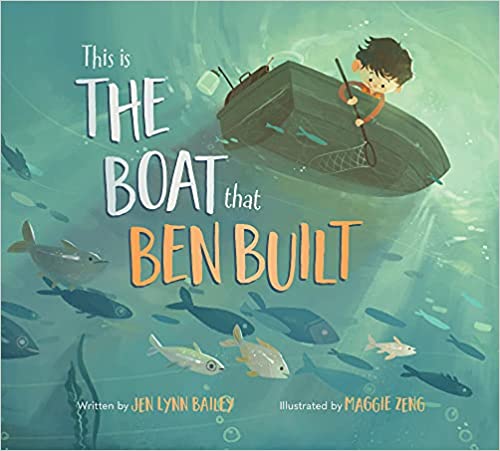
What could be more amazing than experiencing an ecosystem through a story? Or floating down a river into a new world that you can explore? This tale has echoes of the traditional "The House That Jack Built" story, yet Bailey weaves a narrative that is distinctly modern, which Zeng has filled with wondrous illustrations. A young boy named Ben builds a boat and explores a world filled with a fish, a beaver, a bear, a goose, an owl, a heron, and a moose while floating down a river on a sunny afternoon. Young readers will enjoy following Ben's adventures and encountering creatures that leap across the river and become larger-than-life within this imaginative journey. This book contains a timeless narrative that will enchant readers of all ages, a revision of a well-known story that is perfectly suited to a twenty-first-century world. With its lyrical text and amazing tapestry of illustrations, this book is destined to become a classic.
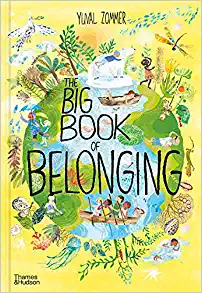
We are all connected with nature in many different ways, author-illustrator Zommer reminds us in the text and images of this oversized feast for the senses. By the turn of the last page—or, more likely, sooner—readers will be eager to mindfully consider and engage with the natural world around them. Each two-page spread has a different heading, including Who is with us?, We are all unique, Wonderful water, Growing up, Teamwork, Shedding, Across the world, Brilliant bones, Time for bed, and many more. Brief paragraphs provide additional information about each topic; for example, the Who is with us? Each spread includes paragraphs with summaries about the categories of the world's inhabitants: mammals, invertebrates, fish, birds, plants, amphibians, and reptiles. We are all unique looks at differences in appearance, from differences in foliage patterns to unique zebra stripes, patterned shells to giraffe spots, and even snowflake differences. The final section, Give nature a helping hand, offers suggestions for how readers can help the nature around us, from making a toad abode to saving the weeds and more. Includes typical nonfiction features such as a table of contents, a glossary, and an index, as well as a "find the footprints" activity readers can complete as they read. Both the words and the pictures are by Zommer, and readers may be hard-pressed to choose which of these features they like better. The sumptuous illustrations are so highly detailed that readers will want to have a copy to pour over time and again, and these are well-supported by text that is suitably detailed for intermediate and upper elementary readers. Highly recommended for use in the science classroom or to support social studies discussion about communities and the world around us.
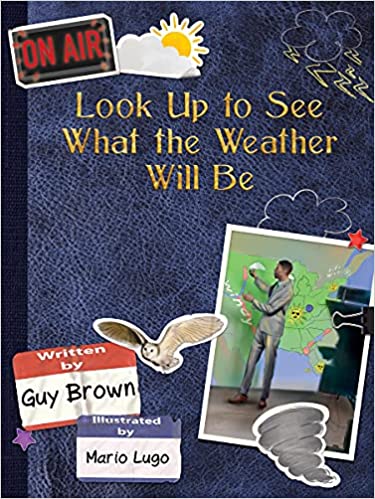
A better name for this book would have been Look "Around," as the major focus is the ability of animals to adapt to the weather. For example, horses not only can detect changes, such as tornadoes but also change the sound of their neighs and snorts to alert others of danger. An elephant can hear approaching storms miles away and protect its young by standing above them. A barn owl's feathers, unlike other birds, are not waterproof–they must shelter during rain. Each animal's adaptation to weather is compared to that of a human: We seek shelter when it rains; we must become safe during a tornado; we do everything to keep our children safe. The illustrations in this book are remarkable, drawing readers into the scene, giving the sense of being a part of the story. We find ourselves sailing with sea lions and protecting ourselves with the camels in the desert. Every animal is incredibly lifelike and greatly adds to the description. This book is important because it introduces a real scientist who shows us ways to measure our own weather patterns and explains the importance of technology in weather prediction. The writer's style is light and personal; the accompanying illustrations give the sense that he is alongside the reader. Although some of the words may be difficult at first to the younger reader, his unique way of introducing weather words will delight those who wish to learn more about this necessary part of everyone's life: weather. This is a book to read and enjoy over and over. Also, should a teacher wish to make this a part of their science curriculum, a guide is readily available.
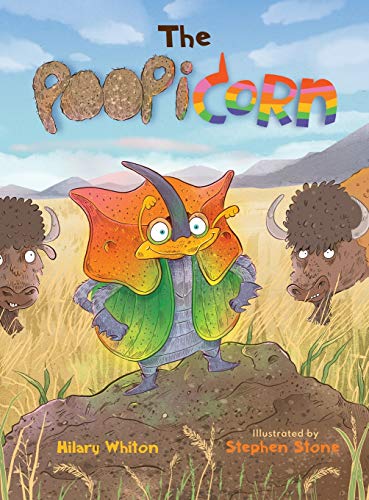
Dung beetles may not have the most glamorous job, but they are a critical participant in the grasslands ecosystem. Cozmo the dung beetle is great at locating piles of poop on the prairie, but he is not so adept at landing in them. Despite multiple attempts, he tends to arrive everywhere except his desired destination. One day, he tries a completely different tactic and finds himself face to face with a beautiful, hornless dung beetle named Rose. Together, they bring poop into their underground home while fertilizing the grasses above and making their world altogether more lovely. This unexpected picture book tells the true story of the dung beetle in a fictionalized context. Within the narrative, readers will find references to typical dung beetle behavior and how it improves the surrounding environment. An extensive interview with Dr. Frank Krell, the Senior Curator of Entomology at the Denver Museum of Nature and Science, is included at the end of the book and reinforces the factual data in the story. Colorful, cartoon-like illustrations depict the landscape of the American Great Plains in an approachable way, adding recognizable human expressions to the animals and bugs featured. Silly inclusions of onomatopoeia presented in poop and flies rating Cozmo's landing skills enhance the visual appeal of this book for children. Elementary school-aged readers will appreciate the uninhibited discussion of poop in this story, especially as it is juxtaposed against the image of the sparkling-white unicorn. Direct, accessible sentences form the narrative, making this mid-length book especially enjoyable to children in a read-aloud setting. This entertaining story educates readers of all ages about the lesser-known life of the dung beetle in an unusual and memorable way and will benefit classroom curriculum about the many creatures who call the American Great Plains home.
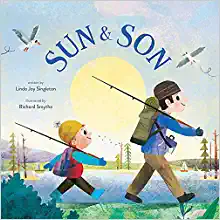
This is a simple book, it would seem. But it is not really because of the word pairing and delightful illustrations. The book shows that the same word can be used to describe human interactions and natural phenomena. For instance, as the sun rises, a father tells his son to rise for the camping and fishing trip they are taking to celebrate the boy's birthday. On the trip, the son and father do many of the same things that the natural world is doing. The illustrations are lovely and gentle, and a great deal of visual imagery is used to stimulate the child's imagination. Adults reading along with child readers will easily be able to point out bits of nature to reinforce the concepts. This is the kind of book that becomes a favorite for the young reader and soothes the grown-up's soul. A lovely bedtime book to read, sending the child to sleep with comforting images.
Kathy MacMillan
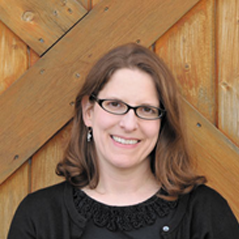
Kathy MacMillan is a writer, American Sign Language (ASL) interpreter, librarian, signing storyteller, and avowed Hufflepuff. She writes picture books (the Little Hands Signing series and The Runaway Shirt from Familius Press), children's nonfiction (She Spoke: 14 Women Who Raised Their Voices and Changed the World, Familius Press), and young adult fantasy (Sword and Verse and Dagger and Coin, both HarperTeen). She has also published many resource books for educators, librarians, and parents. In addition, Kathy presents ASL storytelling programs, author programs, writing workshops, and professional development programs for librarians and educators.
Kathy is available for both in-person and virtual visits. Kathy's presentations, whether for preschoolers and their parents or children and teens, feature American Sign Language activities.
Sneed B. Collard III

Sneed B. Collard III is the author of more than eighty-five books for young people, including his new picture books, Waiting for a Warbler and Beaver and Otter Get Along . . . Sort of. More than a dozen of his books have been Junior Library Guild and AAAS Outstanding Children's Science Trade Book selections. Sneed has been honored with the Washington Post-Children's Book Guild Award for Nonfiction for his body of work. In addition to his nonfiction, Sneed has written several popular novels, including Dog Sense, Flash Point, Double Eagle, Cartwheel—A Sequel to Double Eagle, Dog 4491, and the Slate Stephens Mysteries titles, The Governor's Dog is Missing and Hangman's Gold. Sneed is a popular, award-winning speaker and has visited more than six hundred schools and been invited to more than one hundred professional educational conferences.
Sneed is available for both in-person and virtual visits throughout the U.S. To research and write his nonfiction books, Sneed has traveled to Australia, Costa Rica, Southeast Asia, South America, and the deep-sea floor, making many of his presentations great for STEM and STEAM events and assemblies.
Connect with Sneed and Kathy through Children's Literature's Booking Service.

Children's Literature's Booking Service provides direct contact with each listed author and takes no commission fees from authors or event coordinators.
Francine Jackson
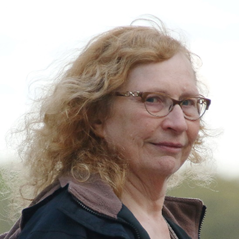
Francine Jackson has been an avid reviewer for Children's Literature for many years. She has a bachelor's in Astronomy and a master's in Education and has been involved in formal and informal programming and teaching for decades. Francine writes a weekly astronomy email for Brown University's Ladd Observatory, plus a monthly astronomy/life-related article for Rhode Island's Amateur Astronomy newsletter. In addition to children's reviews, she reviews astronomy books for the International Planetarium Society's Planetarian Quarterly. Francine wanted to be an astronomer since the age of 8 and feels fortunate that her neighborhood library had quite a few books on the subject. She kept reading all the books the library had on astronomy and now gives back by donating most of the books she reviews to her current local library. Francine says, "For some people unable to purchase all the great new books offered, a library is the perfect place to go." You can find Francine reading mysteries, early science fiction, and books about science. But if she were snowed in, Francine admits she would read anything. "I will read any book, as long as it is interesting, and there is something to learn from it, although a set of Agatha Christies might be a good choice as well." In addition to astronomy and reading, Francine enjoys writing and crocheting.